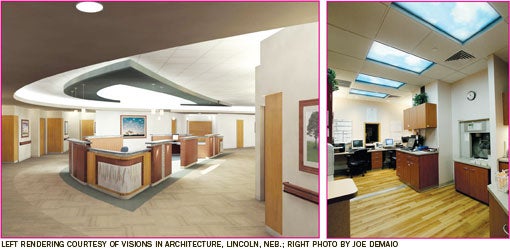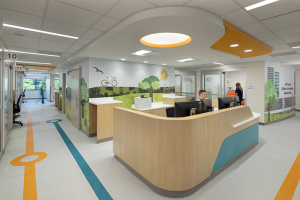Helpful hues
 Health care interior environments include a number of elements that must work together to create a healing space. There are many regional and cultural variables about which a designer can make educated generalizations, but how patients and staff react to these elements are out of a designer's control.
Health care interior environments include a number of elements that must work together to create a healing space. There are many regional and cultural variables about which a designer can make educated generalizations, but how patients and staff react to these elements are out of a designer's control.
Everybody's experience is unique. For example, a picture of the ocean is a comforting reminder of nature for most people, but for some it may bring back memories of an unpleasant experience.
Through the study of epigenetics, there is research available that proves how the
color of light can have a profound effect on circadian rhythms, which affect a patient's ability to heal more quickly. It doesn't matter what an individual's culture or personal experience is — these reactions are built into human behavior.
Epigenetic design is based on how the body and brain receive, perceive and interact with the physical environment. Epigenetic design can be very simple once interior designers understand the research and how patients and staff are affected by the built environment.
The color of light
In the study "Effects of lights of different color temperature on the nocturnal changes in core temperature and melatonin in humans" (www.ncbi.nlm.nih.gov/pubmed/8979406), the authors found that light with a high color temperature of 6,500 kelvin (cool blue light) suppressed the nocturnal fall of the core temperature and the amount of melatonin produced by the body. Low-temperature light of 3,000 kelvin (warm light) did not suppress either of these biological reactions.
In simple terms, exposure to cool light at night essentially wakes up your body. If one thinks about the cycle of the 24-hour day, for instance, the temperature of daylight at sunrise is a cool blue. As the day progresses, the color of daylight changes. By sunset, when bodies are winding down and preparing for sleep, the light is very warm. This is mother nature and human instinct at work.
For human beings' circadian rhythms to stay in balance they need their core temperature to drop and their production of melatonin to increase during the night.
Additionally, research shows the influence of light in different temperatures on humans also affects blood pressure and heart rate. Light with a high color temperature has different physiological effects in humans compared with light having a low color temperature.
Naturally, sunlight resets the internal biological clock every day so it is synchronized with a 24-hour day. If an average person is deprived of natural sunlight on a daily basis, he may continue to follow a 24-hour sleep/wake pattern, but his cycles slowly will become out of sync with actual daytime and nighttime.
Lighting technology options
In a typical hospital, patient rooms have night lights, monitors and digital displays emitting light and making noise. Staff areas are windowless, brightly lit environments 24 hours a day. Interior designers may not have control over the light emitted by monitors and medical equipment, but they can control the colors of the light sources and provide the correct lamps in the spaces they design.
Lighting technology is not yet capable of simulating a day's change in light color throughout a facility, but there are affordable things that can be done with today's technology.
This challenge has been taken to a new level at the University of Wisconsin Hospital and Clinics (UWHC) in Madison. The 2 million-square-foot facility offers very little access to daylighting. Where natural daylighting is unavailable, the facility has injected artificial lighting to accommodate the human need for daylighting. With the help of a local lighting consulting firm, UWHC has drafted its own lighting standards, which it will apply throughout the facility to help establish and maintain a consistent circadian rhythm for its patients.
Faux skylights or miniature luminous ceilings have been used in patient exam and recovery rooms, as well as in staff areas. The faux skylights are deeply recessed troffers with a simulated sky panel diffuser and grid riser. For people who need a connection to outside, they seem like the real thing. The light is from a T5 fixture with a color temperature of 4100 kelvin and a color rendering index of 85.

LEFT A conceptual image of a nurses' station designed with a large skylight to bring much-needed natural daylight to caregivers. RIGHT Faux skylights in an interior staff workroom at University of Wisconsin Hospital and Clinics give caregivers an illusory connection to daylight
This lamp combination is critical for reinforcing the daylight coloration. Warmer color temperature lights exaggerate skin colors and make it more difficult to conduct an accurate visual triage. With this combination, the skin tone of people needing medical attention is more accurately represented.
The color of light was taken to another level in the design of UWHC's emergency waiting room. The color of lights has been synchronized to the way humans respond to light. The lighting consultant selected two colors that are closest to the light wavelength or color to which the human eye is the most receptive — a bluish and a greenish light. The consultant installed 11 translucent, Lycra-wrapped 4-foot by 4-foot custom fixtures that resemble abstract clouds in their shape and opaque nature. The fixtures slowly cycle between the blue and green shades of light.
The idea is that the emotions of people in stressful situations will be calmed with the conveyance of brightness from the light fixtures. A post-occupancy evaluation conducted by the hospital confirms that the result is an environment that minimizes anxiety and has a soothing effect. By minimizing patient anxiety, the healing process can begin as soon as the patient enters the emergency waiting room.
Combined with daylighting
For new facilities, natural daylight is the best option whenever possible. Skylights for internal spaces can be used in public waiting rooms, staff break rooms and even above nurse stations. Caregivers work long hours in high-stress conditions and are often deprived of natural daylight, which is the main driver regulating our circadian rhythm. Caregivers need their circadian rhythm regulated just as much as their patients do.
Interior healing gardens and courtyards also can be designed to help break up a large facility and allow a place for exterior windows. Not only does this provide the benefits of daylighting, but it also adds nature and landmarks to aid in wayfinding. All of this adds to creating a soothing and less-stressful environment.
Large windows should be used in patient rooms, with draperies that can completely block out light from outside at night.
Patients who are in the hospital for more than a few days can have significant problems regulating their circadian rhythm. Daylight from windows can help greatly, but if lights from the exterior leak in at night, it can add to the stress of the various monitor lights and noises. Patient night lights should be set as dimly as possible and in a warm color temperature to avoid stimulating and waking the patient so that he or she is unable to fall back to sleep.
Other procedure rooms, such as magnetic resonance imaging and linear accelerator rooms that often are located toward the middle or in the basement of a facility, also should be given extra attention because the level of stress for patients in these areas can be especially high. Concepts that may be used include faux skylights and abstract clouds with light colors that are known to reduce stress.
There are several lighting manufacturers that provide backlit translucent skies, and some produce fixtures that can be used in rooms requiring nonferrous metal. They can be a great way to fulfill the need to see daylight. Designers should pay special attention to the color of light these fixtures emit because some also utilize light-emitting diode (LED) lights.
Indeed, LED is a big part of new and upcoming lighting technologies. LED lights emit very cool illumination. Early evidence has found the specific light wavelength emitted by LEDs affects physiology faster than incandescent and fluorescent fixtures.
Ultimately, the best lighting systems adjust and change color throughout the day to mimic that of the sun. A more practical solution, given today's technology, is to locate and design spaces to bring natural light into the patient care and staff areas to the greatest extent possible.
Designers then should supplement the natural light sources with lighting systems that have the correct color temperature for the task assigned to the space.
All about physiology
A lighting system's effect on an individual's physiology does not vary from person to person, regardless of cultural or personal background.
Many health care interior designers have arranged patient spaces for aesthetic appeal alone. However, it is now clear through evidence-based design that a number of key factors can help improve patient outcomes and enhance the clinical staff's work environment.
The color of the health care facility's lighting should not be overlooked as one of those key factors.
Penny Johnston, AAHID, IIDA, EDAC, LEED AP, has a background that includes working for a furniture dealer, a medium-sized architecture/engineering firm, a regional medical center and, most recently, as the interior designer for a small architectural firm specializing in health care design. She can be reached at penny@huffakerassociates.com.
| Sidebar - Lighting color design terms |
The role of health care lighting and the influence of lighting color on patients and staff encompasses biology, technology and aesthetics. Following are a few definitions that will help readers navigate these interrelated subjects: • Circadian rhythm. An internal biological clock that carries the genetic instructions to produce proteins. The levels of these proteins rise and fall in rhythmic patterns. These oscillating biochemical signals control various functions, including when people sleep and rest, and when they are awake and active. Circadian rhythms also control body temperature, heart activity, hormone secretion, blood pressure, oxygen consumption, metabolism and many other functions. • Color rendering index (CRI). The CRI is a measure of how accurately an artificial light source displays colors. It is determined by comparing the appearance of a colored object under an artificial light source with its appearance under incandescent light. The higher the CRI, the better the artificial light source is at rendering colors accurately. • Color temperature of light. Color temperatures over 5,000 kelvin are called cool colors (bluish-white), while lower color temperatures of 2,700 to 3,000 kelvin are called warm colors (yellowish-white through red). • Epigenetics. The development and maintenance of a living organism is orchestrated by a set of chemical reactions that switch parts of the genome off and on at strategic times and locations. Epigenetics is the study of these reactions and the factors that may influence them. • Epigenetics and the environment. The genome dynamically responds to the environment. Stress, diet, behavior, toxins and other factors activate chemical switches that regulate gene expression. |




